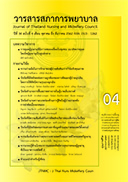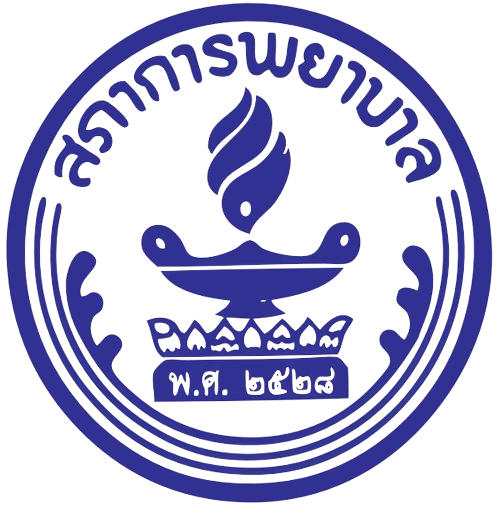Nutrition Literacy and Health Outcomes in Older Adults with Type 2 Diabetes
Keywords:
nutrition literacy, personal factors, health outcomes, older adults with type 2 diabetesAbstract
Objective: To investigate older adults with type 2 diabetes in terms of their 1) overall nutrition literacy, basic, interactive and critical aspects of their nutrition literacy; 2) relationship between personal factors and nutrition literacy; and 3) relationship between nutrition literacy and health outcomes.
Design: Descriptive correlational research.
Methodology: The participants, recruited through purposive sampling, were 300 older adults with type 2 diabetes being treated at the diabetes clinic of a community hospital in Pathum Thani province. Data were collected using a questionnaire and a health outcome record form. The data were then analysed using descriptive statistics, biserial correlations, and Spearman’s correlation coeffcient.
Results: The majority of participants possessed a moderate degree of overall nutrition literacy, showing moderate nutrition literacy degrees at both the basic and interactive levels. At the critical level, on the other hand, a moderate degree of nutrition literacy was observed amongst early older adults and mid-older adults, whilst a low degree was observed amongst late older adults. The participants’ personal factors, namely, age, education level, income and nutrition information resources, were signifcantly correlated with their overall nutrition literacy. Their overall nutrition literacy was also signifcantly related to their waist circumference. Finally, a statistically signifcant relationship was identifed between the participants’ functional and critical nutrition literacy and their diastolic blood pressure.
Recommendations: It is recommended that nurses and healthcare team develop appropriate materials and methods, as well as diversify communication channels, to properly promote nutrition literacy amongst older adults with type 2 diabetes. Patients with a particular need of these forms of support include late older adults with low education, low income and limited access to nutrition information. Also, family members and caregivers should be engaged to promote nutrition literacy and initiate appropriate food consumption behaviours, to help older adults with type 2 diabetes produce desirable health outcomes.
Downloads
References
Surveillance Report, 2012 Weekly Epidemiological Survillance Report 2013; 44 (51): 802 -7. (in Thai)
2. Offce of Promotion and Protection of the Elderly, Ministry of Social Development and Human Security.
Situation of The Thai Elderly 2011 . 2013 [cite 2016 august 16] Available from: https://www.m-society.
go.th/article_attach/13225/17347.pdf
3. Deerojwong C. Diagnosis and classifcation of diabetes: Thai Association of Diabes Educator. Basic-course.
Bangkok 2010: 40- 6. (in Thai)
4. Mauk KL. (Editor) Gerontological nursing: competencies for care. (2 nd ed.).United States of America: Jones
and Bartlett Publishers ; 2010: 178 -80
5. Patel P, Abate N. Body Fat Distribution and Insulin Resistance. Nutrients 2013; 5: 2019-27.
6. Huebschmann AG, Regensteiner JG, Vlassara H, Reusch JEB. Diabetes and Advanced Glycoxidation
End Products. Diabetes Care 2006; 29:1420-32
7. Annuzzi G, Natale DC, Iovine C, Patti L, Marino LD, Coppola S, et al. Insulin resistance is independently
associated with postprandial alterations of triglyceride rich lipoproteins in type 2 diabetes mellitus. arteriosclerosis
thrombosis Vascular Biology 2004; 24: 2397–402.
8. Adiels M, Boren J, Caslake MJ, Stewart P, Soro A, Westerbacka J, et al. Overproduction of VLDL1 driven
by hyperglycemia is a Overproduction of VLDL1 driven by hyperglycemia is a dominant feature of
diabetic dyslipidemia. Arteriosclerosis Thrombosis Vascular Biology 2005. 25:1697–703
9. Vergès B. Abnormal hepatic apolipoprotein B metabolism in type 2 diabetes. Atherosclerosis 2010;211: 353–360.
10. Diabetes Association of Thailand under The Petronage of Her Royal Highess Princess Maha Chakri Sirindhron,
The Endocrine Society of Thailand, Department of Medical Service; Ministry of Public Health, National
Health Security Offce. Diabetes clinical practice guideline for diabetes 2014; Bangkok. (in Thai)
11. Kongsomboonvech S. Dietary management for treatment of diabetes: Thai Association of Diabetes Educator:
Basic-course.Bangkok 2010; 71- 110. (in Thai)
12. Hudthagosol C. Reading The Nutrition Facts Label can helps control diabetes mellitus. 2014 [cite 2016
august 16] Available from: https://mgronline.com/ qol/detail/9560000081929.
13. International Food Information Council Foundation (IFIC). food & health survey: Consumer attitudes
toward food safety, nutrition & health; Executive summary & key trends 2011. [cite 2016 sep 16] Available from https://foodinsight.org/wpcontent/ uploads/ 2011/05/fnal-executive-2011.pdf
14. Zoellner J, Connell C, Bounds W, Crook L,Yadrick, K. Nutrition literacy status and preferred nutrition communication channels among adults in the lower Mississippi delta. Preventing Chronic Disease 2009; 6(4): 1-11.135
15. Pettersen S, Kjøllesdal JG, Aarnes SB. Measuring nutrition literacy. Paper presented at the 19 th International Conference of Nutrition, Bangkok, Thailand. 2009.
16. Aihara Y, & Minai J. Barriers and catalysts of nutrition literacy among elderly Japanese people. Health Promotion
International 2011; 26(4): 421-31.
17. Nutbeam D. Health Literacy and adolescents: a framework and agenda for future research. Health
Education Research 2008; 23(5): 840-47.
18. Division of Health Education, Department of Health Survice Support, Ministry of Public Health. A Guide to
health literacy for promoting health beheavior of people who are at risks for type II diabetes and hypertension. Ministry of Public Health; Nonthaburi; 2013. (in Thai)
19. Intarakamhang U, Malarat A.& Division of Health Education, Department of Health Survice Support,
Ministry of Public Health. Guidelines for developing health literacy to change behavior and risk reduction
according to indicator of people who risk to type 2 diabetes / hypertension Nonthaburi; 2013.(in Thai)
20. Patel P, Panaich S, Steinberg J, Zalawadiya S, Kumar A, Aranha A, Cardozo L. Use of Nutrition Literacy Scale
in elderly minority population. J Nutri Health & Aging 2013; 17(10): 894 -97.
21. Department of Medical Service, Ministry of Public Health. Abbrevated mental test in manual to screening /
evaluating aging people. 2015; 26- 27. (in Thai)
22. Krejcie R.V., & Morgan D.W. Determining sample size for research activities. Educational and Psychological
Measurement; 1970.
23. Gibbs HD. Nutrition Literacy: Foundations and development of an instrument for assessment. (Doctoral dissertation)
University of Illinois; 2012.
24. Suwanwalaikorn S, Chandraprasert S. (Editor) Handbook for diabetes education. Faculty of Medicine
Chulalongkorn University. 2003. (inThai)
25. Bari N. Nutrition literacy status of adolescent student in Kampala district, Uganda (Master thesis) Oslo and
Akershus University College of Applied Sciences; 2012.
26. Assantachai P. (Editor) Common health problems in the elderly and protection, 2nd ed. 2011. (in Thai)
27. Nguyen HT, Kirk JK, Arcury TA, Ip EH, Grzywacz JG, Saldana SJ, et al. Cognitive function is a risk for
health literacy in older adults with diabetes. Diabetes Research and Clinical Practice 2013; 101: 141 -147.
28. Gibbs HD, Ellerbeck EF, Gajewski B, Zhang C, Sullivan DK. The Nutrition Literacy Assessment
Instrument is a valid and reliable measure of nutrition literacy in adults with chronic disease. J Nutr Educ
Behav 2017; 50: 247–57.
29. Kaeodumkoeng K, Tripetchsriurai N. Health literacy. Bangkok: Newtumada Printing (Thailand) Co., Ltd;
2011; 1-25. (in Thai)
30. Khumthong T, Pothisiri W, Kaeodumkoeng K. Factors influencing health literacy for people at risk of diabete
mellitus and hypertension of UthaiThani and Ang Thong. Veridian E-Journal, Science and Technology Silpakorn
University 2016; 3(6): 67- 85. (in Thai)
31. Osher E, Stern N. Diastolic Pressure in Type 2 Diabetes; Can target systolic pressure be reached without “diastolic
hypotension”? Diabetes care 2008; 31(2):249-254
32. Morris NS, MacLean CD, Littenberg B.Literacy and health outcomes: a cross-sectional study in 2002 adults
with diabetes . BMC Family Practice 2006;7,49 .
33. Montoya M.F. The association between health literacy and diabetes outcomes and self-management behaviors
among older adults in the U.S. (Doctoral dissertation) Fort Worth: University of North Texas Health Science
Center; 2015.
34. Yamashita T, KART CS. Is diabetes-specifc health literacy associated with diabetes-related outcomes in
older adults? Journal of Diabetes 2011; 3: 138–46.








